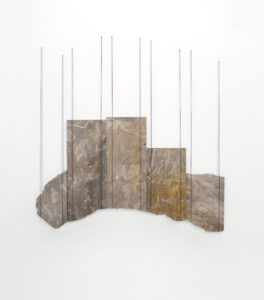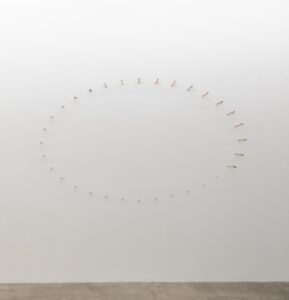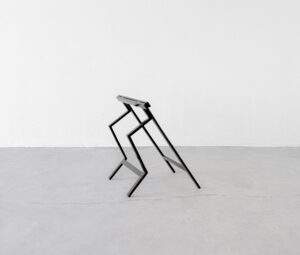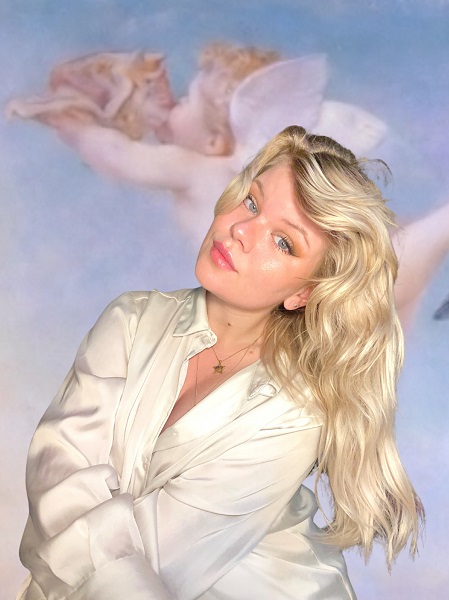«In every action, in addition to what is done, the intention, the reason why it is done counts» says Giacomo Rizzolatti, discoverer of mirror neurons. A responsible trade. Giving and receiving. Giving back to space, to man, to the Universe. The doctor with the patient, the vegetables with the farmer, the pianist with the piano. According to the publication Psychosomatic Medicine: Journal of Biobehavioral Medicine, neuronal activity is much more dynamic when there is care for the other. On a neurobiological level we are predisposed to altruism. A pre-social empathy, a sort of disinterested Kantian a priori judgment.

Space as a duty of care, installation view, courtesy of the artists and Galleria Studio G7, Bologna. Photo Francesco Rucci
Galleria Studio G7 hosts Space as a duty of care, curated by Daniele Capra. The exhibition features works by Simon Callery, Anneke Eussen, Jacopo Mazzonelli, Goran Petercol and Silvia Stefani. Five artists, aware, take responsibility for the host space, entering it almost on tiptoe. Not only that, the responsibility also falls on those who will immerse themselves in the space itself, already contaminated by the works of these, as long as it respects the other and vice versa. The object thus assumes a position and the claim of empathy as well as the shrewdness of third parties. Duty of care comes from the Anglo-Saxon common law and provides for respect for objects, space, the community and the history that constitutes the macro-world. Everything is enclosed in space as a playground of the same law, albeit instinctive and natural.

Space as a duty of care, installation view, courtesy of the artists and Galleria Studio G7, Bologna. Photo Francesco Rucci
Simon Callery‘s artistic research, represented by the work Foot-Neck Wallspine, starts from landscape painting, from the medium of a canvas or panel to translate the view as a physical, material body present in space. The work is visible from inside to outside and vice versa. The eye can scroll through the filaments, slip between a void and a fullness; sometimes with the sense of smell, feeling the effluvium of the tempera with egg binder, a technique dear to Cennino Cennini and which takes us back to the great Flemish masters. We are not looking at nature: Callery gives us the possibility of being in nature in its necessary elementality.

Anneke Eussen, There is no going back, 2020, marble, black threads and nails 135 x 120 cm. Courtesy of the artist and Tatjana Pieters, Ghent. Photo A. Eussen
To introduce to the work of Anneke Eussen, I quote one of the most incisive sentences ever read in my experience: «Animum debes mutare, non caelum», by Seneca. The artist changes the fate of what she touches. Each recovered material acquires a new intent, and at the same time directs the artistic process. This is the case of There’s no going back, made marble blocks recovered from the state library of Berlin. Each block has its own particular cut which, coming into contact with the remaining blocks strategically arranged by the artist, forms a wave suspended by black ropes and nails. There is no return, as the physicist reaches its highest intent, in its minimalist finality.

Jacopo Mazzonelli, Etude, 2023, piano hammers, variable dimensions. Courtesy the artist and Galleria Studio G7, Bologna. Photo Francesco Rucci
Jacopo Mazzonelli instead plays with what fills the space. It could be silence, tension, nitrogen, oxygen, carbon dioxide. Elements that make up his work, his Étude. We are faced with piano hammers, each of them manifesting itself in varying measures. We are following a centric melody, we can only hear it with our eye. The oxymoronic deafening silence makes us perceive its absence, yet we remain aware that we are looking at a musical composition, as if, all of a sudden, we could hear it. A solfeggio lesson, complete with a graceful movement of the wrist in two quarters, but we do not see the notes, thus remaining a secret, dreamlike, evolving flow.

Space as a duty of care, installation view, courtesy of the artists and Galleria Studio G7, Bologna. Photo Francesco Rucci
Goran Petercol‘s artistic semiology is based on the search for meaning in the sign, as a relationship between what is present and what is absent. A shared langue, to understand it à la Ferdinand de Saussure. The work in question is Completed with the first, which is limited to the visual indispensable, since it refers to the field of the absent sign, giving a broad and personal perspective. The object has its own language, it is related to other objects, with which it communicates through signs. Petercol lets the right synthetic combinations make the phoneme heard. In this regard, let us consider the πολιτικῶς ξῆν, living socially and politically, therefore in relation to the other. Retracing Aristotelian thought up to Ugo Grozio, it is affirmed that the individual, by nature, is led to live in a rationally organized society. However, this cannot exclude individuality and peculiarity, which come into contact with as many singularities of the other. The difficult, sometimes fragile relationship between man and man is understandable.

Silvia Stefani, Alzarsi o cadere, 2015, wooden easel, acrylic paint, 75 x 70 x 65 cm. Courtesy the artist. Photo Nico Covre
Silvia Stefani transmutes material compositions, extracting them from the possible teleological sense, making the complex human relationship visible through the material. Alzarsi o cadere can only involve us empathically, as if we were ready to interact with the work, straighten it, and if it should fall, we would be ready to support it as both we and the work become interaction. Leaving the Galleria Studio G7 space sparks a faint hope.
Info:
Simon Callery, Anneke Eussen, Jacopo Mazzonelli, Goran Petercol e Silvia Stefani, Space as a duty of care
20/04/2023 – 20/09/2023
Galleria Studio G7
www.galleriastudiog7.it

Born in 1999. She falls in love with art by looking at her mother’s paint. She’s studying History of Art at the Ca’ Foscari University (Venice) and in the meantime divulges online videos of art pills. She deals with contemporary art as a critic, curator and artist.






NO COMMENT